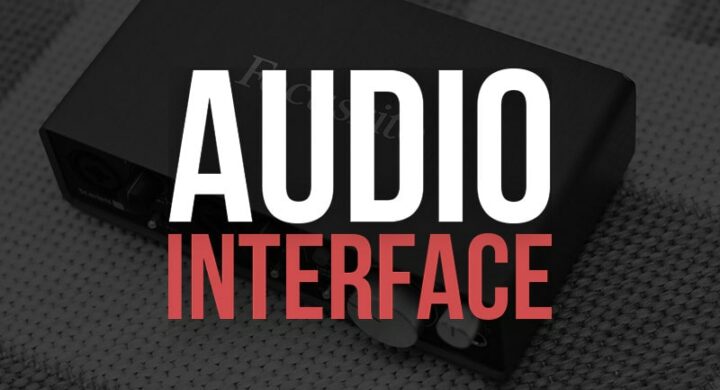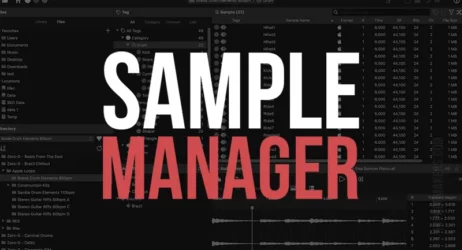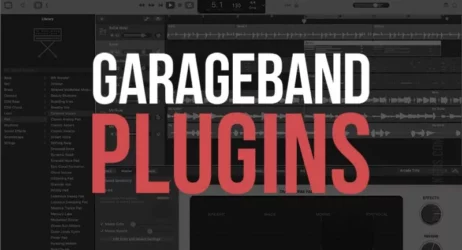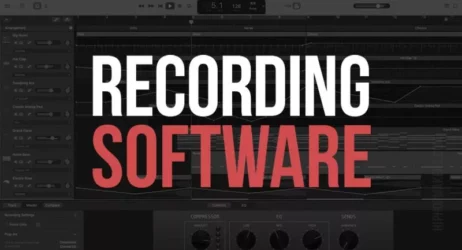This guide will answer what an Audio Interface is, what it does, how it is used, and the best available audio interfaces.
What Is An Audio Interface?
Audio Interfaces are devices that connect to your computer and have analog inputs to accept audio signals from instruments, microphones, or other sources. It converts the analog signal into digital data that your computer can read. They often serve as the central component of home recording studios.
- What Is An Audio Interface
- What Are Audio Interfaces Used For
- How Do Audio Interfaces Work
- What Are the Best Audio Interfaces
- How Do You Use an Audio Interface
- Sound Cards vs. Audio Interfaces
- Is An Audio Interface Necessary

What Is An Audio Interface?
Technology should not interfere with your creativity. However, at a certain point, you rely on it to produce desired results. With the right gear and tools, you can speed up your work and make sure that your listeners hear precisely what you are hearing.
One of the initial decisions you have to make when stepping into the world of music production is to project sound into and out of your computer, where an audio interface comes into play.
An audio interface enables the user to record and play audio from a computer. Although the built-in audio in your computer is quite good, the sound produced by a professional audio interface is way better.
Related: Best USB Audio Interfaces
It also gives the user more options for recording and playback. Many DJs and personal home studios rely on a two-channel USB audio interface for professional recording at home.
An audio interface allows the user to connect various devices like microphones and keyboard cables to a computer and record through USB.
It provides an output on Studio Monitor speakers, computer speakers, and headphones so you can listen to the recorded or real-time input audio to play through your computer.
High-end audio interfaces have an onboard MIDI collection to connect your keyboard or DJ controller to your computer using the audio interface. This saves the cost of purchasing an additional midi interface for your laptop.
Let’s look at the two main types of audio interfaces:
Desktop Audio Interface for Personal Use or Podcasting
This works great for DJ setups and project studios where you require 2 to 6 tracks of audio. These contain audio monitoring controls and headphone jacks on the front side of the desktop.
Rackmount Audio Interfaces for Professional Recording Studio Uses or Project Studios
Geared for professional recording with more refinement and specialization, the rackmount audio interface does not allow as much control on the front of the desktop as a desktop audio interface. It is not meant to be controlled with knobs and buttons but a computer using DAW software. These interfaces are used in serious recording studios where full bands record with several inputs simultaneously. It has a higher processing power and allows users to record higher sound quality settings with a vast dynamic range.
What Are Audio Interfaces Used For?
Audio interfaces ensure high-quality recording and ease of use. One of the significant benefits of using an audio interface is its large size and its easy accessibility. A broader range of input types can be built into the unit, making it function better than existing system cards.
How Do Audio Interfaces Work?
An audio interface is hardware that you use to connect your audio gear, such as instruments and microphones, to the computer. The device functions by converting analog signals into digital audio. This helps your audio computer become readable, and the computer can process it like any other information.
What Are the Best Audio Interfaces?
The correct audio interface depends on how you plan to use it.
Ask yourself these questions:
- How many channels will I record at a time?
- How many inputs do I require simultaneously?
- What is my budget?
Following are some options that you should consider. These are the best-selling audio interfaces on Amazon.
- Pro performance with great pre-amps - Achieve a brighter recording thanks to the high performing mic pre-amps of the Scarlett 3rd Gen. A switchable...
- Get the perfect guitar and vocal take with - With two high-headroom instrument inputs to plug in your guitar or bass so that they shine through....
- Studio quality recording for your music & podcasts - Achieve pro sounding recordings with Scarlett 3rd Gen’s high-performance converters enabling...
- Low-noise for crystal clear listening - 2 low-noise balanced outputs provide clean audio playback with 3rd Gen. Hear all the nuances of your tracks or...
- Everything in the box: Includes Pro Tools Intro+, Ableton Live Lite, six months of FL Studio Producer Edition and Hitmaker Expansion: a suite of...
- The new generation of the songwriter's interface: Plug in your mic and guitar and let Scarlett Solo 4th Gen bring big studio sound to wherever you...
- Studio-quality sound: With a huge 120dB dynamic range, the newest generation of Scarlett uses the same converters as Focusrite’s flagship...
- Find your signature sound: Scarlett 4th Gen's improved Air mode lifts vocals and guitars to the front of the mix, adding musical presence and rich...
- All you need to record, mix and master your music: Includes industry-leading recording software and a full collection of record-making plugins
- Everything in the box: Includes Pro Tools Intro+ for Focusrite, Ableton Live Lite, six months of FL Studio Producer Edition and Hitmaker Expansion: a...
- High-Fidelity 24-Bit/192kHz Recording: Create studio-grade sound for vocals, music, or voice-over projects. Tailored for creators, musicians, and home...
- Real-Time USB Monitoring: Direct signal monitoring keeps you in sync while recording—minimal delay, hassle-free USB power.
- Flexible XLR/Line Inputs with Phantom Power: Two combo ports fit mics and instruments, with 48V power and LED indicators to monitor peaks.
- Driver-Free Operation: Plug-and-record compatibility with Windows, macOS, and major audio software.
- Durable Compact Setup: Sturdy build with all key ports—headphone, stereo out, and USB. Includes both USB-C & USB-A cables.
- Podcast, Record, Live Stream, This Portable Audio Interface Covers it All – USB sound card for Mac or PC delivers 48 kHz audio resolution for...
- Be ready for anything with this versatile M-Audio interface - Record guitar, vocals or line input signals with one combo XLR / Line Input with phantom...
- Everything you Demand from an Audio Interface for Fuss-Free Monitoring – 1/8” headphone output and stereo RCA outputs for total monitoring...
- Get the best out of your Microphones - M-Track Solo’s transparent Crystal Preamp guarantees optimal sound from all your microphones including...
- The MPC Production Experience - Includes MPC Beats Software complete with the essential production tools from Akai Professional
- The new generation of the artist's interface: Connect your mic to Scarlett's 4th Gen mic pres. Plug in your guitar. Fire up the included software....
- Studio-quality sound: With a huge 120dB dynamic range, the newest generation of Scarlett uses the same converters as Focusrite’s flagship...
- Never lose a great take: Scarlett 4th Gen's Auto Gain sets the perfect level for your mic or guitar, and Clip Safe prevents clipping, so you can focus...
- Find your signature sound: Air mode lifts vocals and guitars to the front of the mix, adding musical presence and rich harmonic drive to your...
- With Scarlett 4th Gen, you have all you need to record, mix and master your music: Includes industry-leading recording software and a full collection...
Last update on 2025-10-28 / Affiliate Disclaimer
How Do You Use an Audio Interface?
Let’s go through the basic steps of setting up an audio interface.
- Use the recommended connection or USB to connect your interface to your desktop computer or laptop.
- Install the required or recommended drivers. Sometimes, this update takes place automatically with a newer system, but you will need to download a driver.
- Connect your speakers to the audio interface using the output.
- Install or launch your audio recording or playback software.
- Identify the output of your audio software to direct to your installed audio interface.
- Test the interface by playing back pre-recorded audio from the installed software.
- Connect your inputs like microphones and keyboard cables etc., to the audio interface.
- Run a check on the input signal by routing an input device to input in the software and recording a short clip.
- Play it back on your speakers to check if it’s working.
Once the setup is complete, your audio interface is ready to capture audio signals from a direct input (guitar, keyboard, bass, etc.) or a microphone.
It converts that electrical signal into a digital signal consisting of binary language that your computer can read and understand. You can think of the interface as an advanced outboard sound card with solid preamplifiers and other features.
What Is the Difference Between Sound Cards & Audio Interfaces?
Sound cards and audio interfaces have similar functionality, but there are some significant differences between both devices regarding audio playback and recording.
When an audio interface is connected to your laptop or computer, you bypass the onboard soundcard, so it’s safe to say that an audio interface can replace the sound card. The audio is processed using the interface than the sound card and its drivers. However, sometimes a sound card can perform more capably than an audio interface.
Sound cards and audio interfaces share many attributes. The main difference between them is that an audio interface is an external device that is connected to the computer or laptop using cables. At the same time, a sound card is hardware that is pre-installed in devices.
The sound card provides inputs and outputs, allowing users to send audio into the computer or into headphones and speakers.
Computers are incapable of comprehending audio signals, so a sound card is pre-installed in every device. Although audio interface and sound cards perform the same primary function, an audio interface is the more versatile among the two.
Sound cards work for playing audio from the computer, but they do not offer additional recording and playback options like audio interfaces.
Sound cards commonly feature auxiliary inputs and outputs that support recording to a certain extent, compared to an audio interface’s balanced input. In addition, it is impossible to connect a condenser microphone to a sound card as the small auxiliary input on cards isn’t compliant with these microphones.
Is An Audio Interface Necessary?
You can record basic audio with the sound card on your computer. Still, the basic functionality of these cards falls short in many ways, especially in comparison with external audio interfaces.
Although you don’t need an audio interface to record sound, you need one to record professional, high-quality sound. This includes recording voices, instruments, and other types of audio. The basic sound card doesn’t have the required connections for recording music at a high-quality level.
Let’s look at the reasons why an audio interface is better than a standard sound card.
- It has more ins and outs
- It has no jitters, latency, or noise
- Connects to a wide range of playing equipment and recording
- Delivers higher quality audio than standard sound cards
- Works faster in comparison with traditional sound cards
- Most interfaces offer MIDI inputs and outputs
- Allows you to record and play software-based plugins and instruments
- Use direct monitoring and remove latency
- You can use professional-grade microphones without adapters
Summary of Audio Interfaces
Audio interfaces connect to the computer and provide analog inputs to accept sound from instruments, microphones, or other sources. They convert analog signals into digital data that your computer can read. They are often the center of home recording studios.
I hope you now understand what an audio interface is and how they are used to record music.










